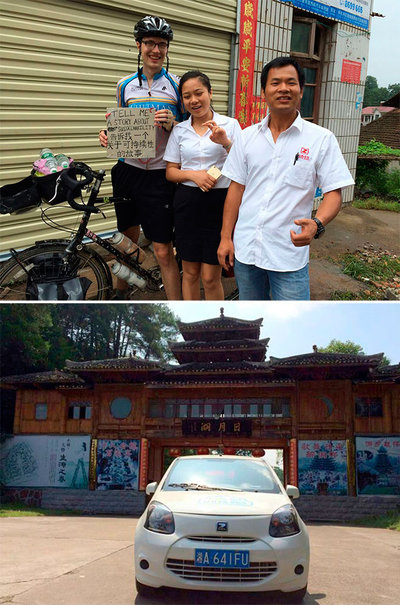A car drops down out of the Hunan countryside, golden hour sunlight glancing of a fresh coat of wax. Pulling into the little dealership’s lot, Li Qiang basks for a moment in the smell of new plastic and fresh vinyl. Then he climbs out and walks to meet his colleagues. In bold stick-on characters, the sides of the cars read “Energy-saving, environment-protecting EV/Electric Vehicle” in Chinese.
Many of the provincial cities of West China have grown up from villages over the past 10 years. They roll down over their valleys’ old terraces, spreading out kilometers of auto shops, repair stores, and distribution centers.
Huaihua, Hunan’s Zotye electric car dealership isn’t on the outskirts with the others, but nestled in a downtown of iPhones and designer brands. We sit down in the air conditioning, and I ask how long they’ve been in business. Li thinks a moment, fingers twitching as he counts. “Twenty — 22 days,” he pronounces. “My friend called me up a few months ago, and I wanted to experience life in the city, so here I am!” He smiles wide.
Founded in 2005 in the eastern province of Zhejiang, Zotye Auto has quickly grown to be a nationwide competitor in China. Though it still lingers around the back of the pack of general market auto producers, the company places second in overall sales of EVs, having ramped up from 220 units in 2013 to more than 8,000 in the first half of this year.
This rapid expansion into the EV market is matched by Li’s salesmanship. His voice is firm and assured when I ask how he sees the future of Chinese EVs. “They are the future of cars, in China and the world. For young people in China, we’ve grown up with constant pollution, and it’s just too heavy for us. We want to do what we can to lift the smog.” With coal-powered generators moving increasingly out of cities and into more remote regions of the country, EVs may indeed have a role in reducing urban pollution in China and its 4,000 person/day death toll. (But not necessarily.)
When it comes to overall CO2 emissions, the picture is more complicated. Despite achieving its first yearly reduction in coal use in 2014, China still gets well over half its electricity from coal. Except for in areas with a high or rapidly growing density of clean energy production, EVs in China may contribute more to CO2 emissions over their lifespans than gas-powered vehicles.
Li doesn’t show any signs of wavering. He lives in a China that has seen Under the Dome, a documentary on pollution in China that was seen by 175 million people in the two days before its removal from Chinese internet. In this world, young Chinese seem ready to jump at any possibility of cleaner skies.
“Pollution is something that affects people all over the world,” Li says. “Everyone can have a part in defending against it.” — Forrest Watkins
Help keep truly independent
local news alive!
As the year wraps up, we’re reminded — again — that independent local news doesn’t just magically appear. It exists because this community insists on having a watchdog, a megaphone and occasionally a thorn in someone’s side.
Over the past two years, you helped us regroup and get back to doing what we do best: reporting with heart, backbone, and zero corporate nonsense.
If you want to keep Eugene Weekly free and fearless… this is the moment.
